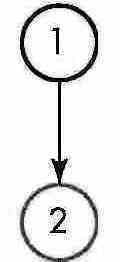CHAPTER ONE: BASIC LOGICAL CONCEPTS
ANALYZING ARGUMENTS
We analyze arguments to see their complexity. Specifically, we diagram the arguments, and this shows us the different and often complex ways their premises support the conclusion. We can also analyze the sentences of an argument to see more clearly what, exactly, its premises and conclusion are.
To diagram an argument, we identify all its premises and conclusions in it and assign each one a circled number. We assign each statement in the argument a number in the order in which the statement occurs in that argument. Thus, for a simple argument with one premise and a conclusion, like “I spent my entire paycheck on lottery tickets yesterday, so I will soon be a rich man.” Here, the single premise is the first statement in the argument so we assign it 1, and the conclusion is the second statement in the argument so it is assigned 2. The argument now looks like this:
1 I spent my entire paycheck yesterday on lottery tickets, therefore 2 I will soon be a rich man.
Then we create a diagram of the argument by letting the circled numbers stand for the statements they are assigned to, place the numbers that represent the premises above the numbers that represent their conclusions and finally, we draw an arrow from each separate premise of the argument to its conclusion. We would thus diagram the above argument like this:

ANALYZING STATEMENTS


